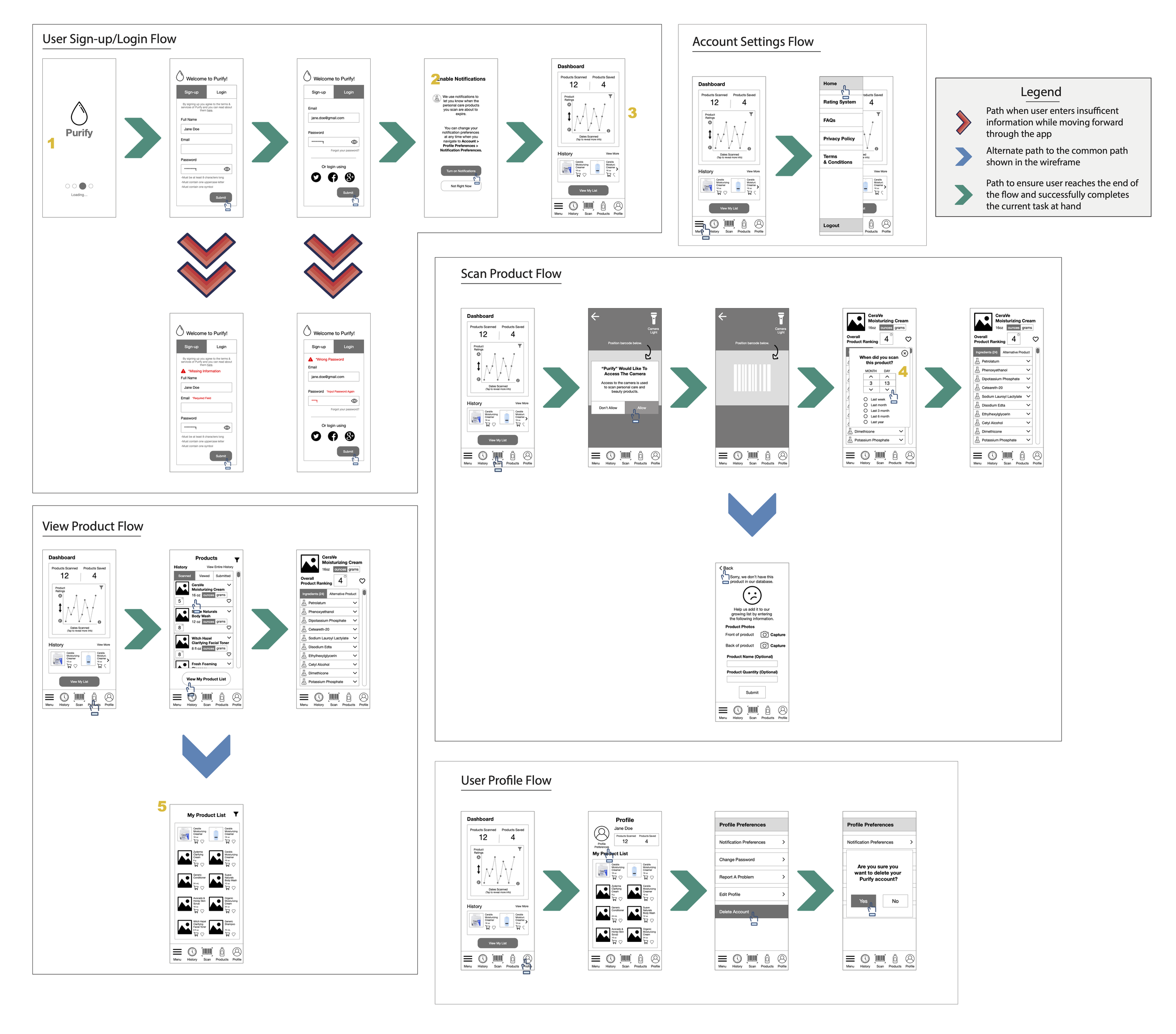Rebrand and Redesign of Think Dirty Mobile Application
Client
Think Dirty
Timeframe
July 2022 - August 2022
Project Type
Master’s Project
Project Overview
The project involved a comprehensive redesign of the Think Dirty mobile application, aimed at enhancing user experience and functionality within the beauty, personal care, and household product information sector. Think Dirty is widely recognized for its capability to inform users about product ingredients via barcode scanning, yet it faced challenges related to usability, data comprehensiveness, and user engagement.
The primary goal was to create a more intuitive and efficient user interface that simplifies the process of understanding product ingredients while expanding the depth of information provided. Key features included redesigning the scanning interface for quicker and more accurate results, improving the clarity and accessibility of ingredient information, and integrating a seamless shopping experience for cleaner alternatives.
Problem Statement
The Think Dirty mobile application, designed to inform users about product ingredients, faces usability and functionality challenges. Users struggle with navigating and understanding product information due to inefficient scanning, limited data depth, and a lack of seamless shopping options for cleaner alternatives. These issues hinder informed decision-making in choosing beauty, personal care, and household products, necessitating a redesign to enhance usability, expand information comprehensiveness, and integrate a smoother shopping experience.
User Pain Points
As stated above, users encounter several pain points when discovering what ingredients are in their beauty, personal care and household products.
Inefficient barcode scanning functionality causes frustration for users.
Limited depth of product information restricts understanding of ingredients.
Absence of seamless shopping options for cleaner alternatives impedes consumer choice.
User Research
The redesign of the Think Dirty mobile application was guided by comprehensive secondary research which sought to uncover user needs, preferences, and behaviors and implement a structured design approach to ensure the new version of the app would meet user expectations and business goals effectively. This structured approach ensured the new Think Dirty app, rebranded as Purify, not only meets but exceeds user expectations, delivering a more intuitive and empowering experience for conscientious consumers.
Phase 1: Project Brief
Beginning with a detailed project brief, the initiative outlined company objectives, described the target user base, assessed competitors, and defined essential functionalities.
Company Info: Think Dirty is a mobile application focused on informing users about product ingredients in beauty, personal care, and household items.
Project Description: Redesign the Think Dirty app to enhance usability, expand information depth, and integrate shopping functionalities for cleaner alternatives.
User Base: Targeted at conscientious consumers seeking transparency in product ingredients and healthier choices.
Competition: Analyzed direct and indirect competitors in the sector to identify strengths and weaknesses in ingredient transparency, usability, and shopping integration.
Functionality Needed: Improved barcode scanning, enhanced product information display, seamless shopping for cleaner options.
Phase 2: Secondary Research
Comprehensive secondary research guided the project from initial brief to final prototype, focusing on enhancing usability and integrating enriched product information and shopping features.
Phase 3: Screenflow/Sitemap
This groundwork informed the creation of a detailed screenflow and sitemap to map out the application's architecture.
Developed a comprehensive screenflow and sitemap to visualize the app's architecture and user navigation flow.
Mapped out key screens such as home, scan, product details, shopping options, and user profile to ensure logical user journey and information flow.
Screen flow Screenshot
Screen flows were instrumental in determining the essential screens required for the initial app designs, this is one of the four main workflows.
Design Process & Implementation
The transition from user research to design implementation involves leveraging insights gathered from secondary research to inform the creation of wireframes and prototypes. This iterative process ensures that the final product meets user-centered goals, providing an intuitive and engaging experience based on comprehensive research findings.
Phase 4: Wireframes
From these blueprints, initial wireframes were developed to address the insights gleaned from secondary research and refined through iterative cycles of peer feedback. These wireframes outlined the app’s interface and functionalities in alignment with user expectations.
Translated screenflow into wireframes to outline basic structures and interactions of each screen.
Iterated wireframes based on peer feedback to refine layout, content placement, and usability considerations.
App Wireframe
Once the wireframes were finalized, they were developed into a clickable prototype, enabling the client to assess the app's functionality through interactive navigation.
Phase 5: Clickable Prototype
Subsequently, a clickable prototype was crafted to simulate user interactions, validate design decisions and refine usability.
Created a clickable prototype using design tools to simulate user interactions and flow within the app.
Incorporated peer feedback to iterate on the prototype, refining user interface elements, navigation paths, and interactive features.
Phase 6: Final Prototype
A final prototype was created to integrate the enhanced usability, enriched information depth, and seamless shopping features.
Iterated the clickable prototype into a final prototype, focusing on polishing visual design, enhancing user experience, and ensuring functionality coherence.
Finalized prototype after additional rounds of peer feedback to ensure alignment with project goals and user expectations.
This structured approach—from initial research and planning through wireframing, prototyping, and iterative refinement—ensured that the redesigned Think Dirty app meets user needs effectively while enhancing engagement and usability.
Outcome
Throughout the project lifecycle, user feedback and industry research guided iterative design improvements. This approach ensured alignment with user expectations and industry standards while addressing previous usability issues. Additionally, backend enhancements were implemented to streamline data updates and ensure real-time accuracy of product information.
The redesigned Think Dirty application not only aims to empower users with transparent product insights but also encourages informed consumer choices by promoting cleaner alternatives. By leveraging modern design principles and advanced technology, the project seeks to redefine how users interact with and trust product information in the beauty and household sectors.
Benchmark criteria
Ultimately, the project's success would be measured by improved user satisfaction metrics and also by its impact on promoting healthier and more informed consumer decisions globally. The redesigned Think Dirty application stands as a testament to innovation in digital product design, catering to the evolving needs of conscientious consumers in today's marketplace.

